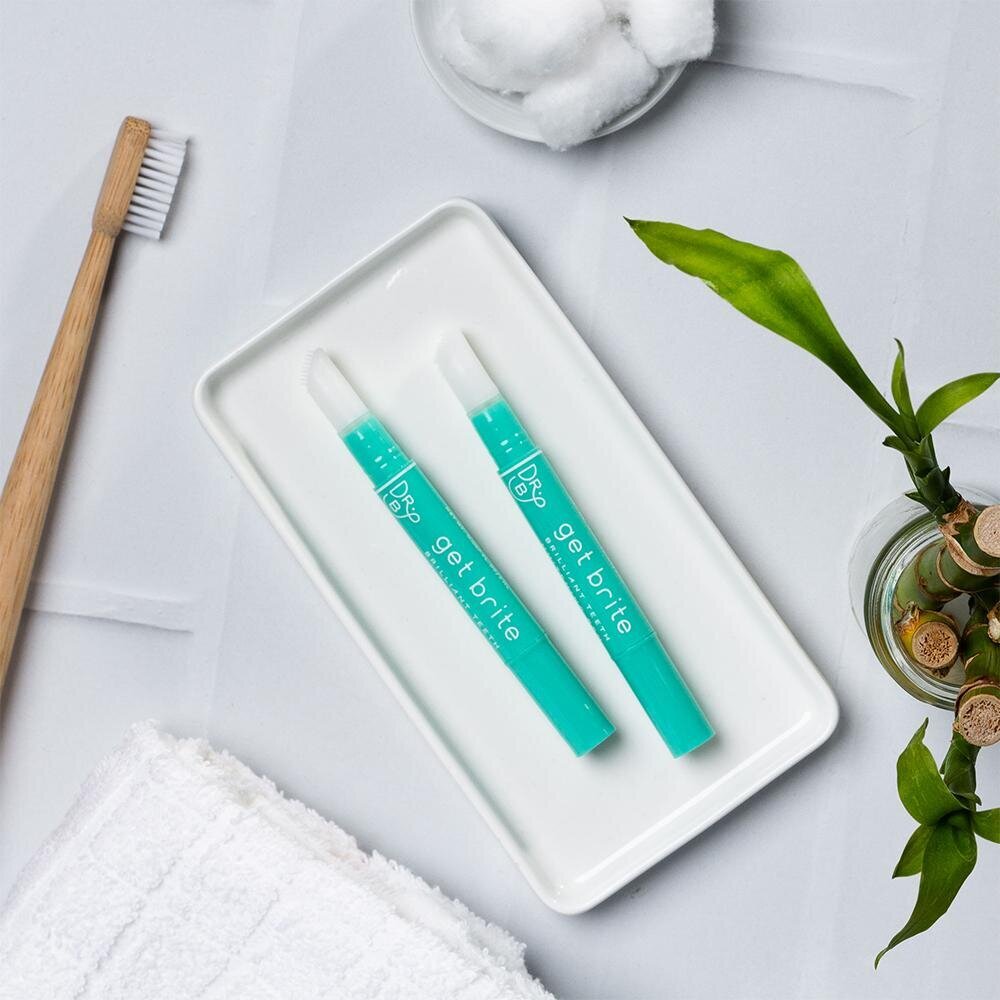
3 Ways To Whiten Your Teeth Naturally—According To Experts
Can You Whiten Teeth At Home?
My smile isn’t always easy to…well, smile about. Despite a tumultuous half-decade of being in braces, complete with expanders, rubber bands, and retainers (that I inevitably stopped wearing), I’ve always been envious of people who sport straight, pearly whites.
“What’s most important is protecting your enamel.”
But lately, I’ve been wondering why we’re so obsessed with having white teeth. We’re surrounded by portrayals of people with gleaming smiles and are told that’s a pinnacle of health and attractiveness—but a bright smile doesn’t necessarily mean you’re at peak dental health. Rather, what’s most important is protecting your enamel. Once it’s gone, it’s not coming back.
Ultimately, everyone’s natural teeth will vary based on genetic and lifestyle factors. It’s okay to want to brighten them, and it’s also okay to embrace them as they are. Consider these options as little optional self-care tune-ups, if you’d like. But most importantly, discuss your options with a dentist who is familiar with your dental health, history, and habits in order to choose the right approach for you.
1. Start With Your Dental Habits
Before you dive into the world of at-home teeth whitening, evaluate the building blocks you have in place. Are you flossing and brushing regularly (and for long enough)?
“A lot of fighting stained teeth is prevention, which means brushing and flossing regularly,“ says Balaji Swaminath, DDS, of Martindale Dental.
Personally, this low-waste flosser from quip has helped me maintain an interest in the practice—which I’ve traditionally avoided. Upgrading your brush, investing in quality toothpaste, or even trying out something like zero waste toothpaste tablets could also help to “freshen” up your brushing habits as well. (Here’s everything you need for a zero waste bathroom routine!)
“Upgrading your brush, investing in quality toothpaste, or even trying out zero waste toothpaste tablets could also help to ‘freshen’ up your brushing habits.”
Particles that linger on the enamel have the potential to increase enamel porosity, eventually seeping in and sealing stains into our teeth—or leading to decay and cavities. It may feel overwhelming, but it can be a helpful upgrade to your routine to brush your teeth an hour after enjoying a meal or drinking soda, coffee, or red wine. (This hour is especially important to protecting your enamel if you’ve eaten acidic foods). If you can’t brush, aim to give your mouth a quick rinse, which Swaminath says will help stop stains from occurring in the first place.
“We also recommend adding fruits and vegetables to your daily diet, especially the crunchy, raw variety,” says Swaminath. “These will help gently rub away the plaque deposited on your teeth while putting healthy vitamins and minerals into your body. It’s a win-win situation all around.”
Essentially, if you want shiny chompers like Bugs Bunny, you’ve got to eat more like a rabbit. Here’s a list of the best produce to eat for optimal dental health.
2. Try DIY Teeth Whitening
While the first and most effective way to maintain a glowing smile is good dental hygiene habits, you may also want to try DIY whitening options, though you’ll want to consult your dentist beforehand.
“Unfortunately, the most common ‘natural’ tooth whitening strategy involves acids (including citrus and fruit juices) combined with gritty toothpastes,” says Paul Springs, DMD, of Queens DDS. Springs explains that, while these strategies can remove stains, they also eat away at the enamel over time. This increases the risk for dental disease and can ultimately lead to less white teeth since the dentin (the layer below the enamel) is often yellow.
“The most universally recommended method from dentists is a simple pantry staple: baking soda.”
The most universally recommended method from dentists is a simple pantry staple: baking soda. It’s finely ground, which means it won’t be too abrasive, and it also has a neutralizing effect on the pH in your mouth. Put simply? It helps reduce the acidity present in your saliva, and in turn, your enamel hardens (or “remineralizes”) and is less porous for the nasties that cause cavities.
If you decide to look for a natural toothpaste with potentially abrasive ingredients, Springs recommends looking for ones with an ADA seal of approval so you know it won’t harm your teeth (see the full list of ADA-approved toothpaste here). “Some whitening toothpastes use grit particles so large that they cause significant enamel loss,” says Springs, “similar to using coarse sandpaper.” Ouch.
If you find other recommendations online (or on Tik Tok, it’s okay to admit it), discuss them with your dentist before trying them. For example, you and your dental care team can talk about how frequently the abrasive activated charcoal should be used in your routine. You might also find some success with other methods, like oil pulling, but no current studies show it effectively whitens teeth.
3. Consider Natural At-Home Whitening Products
There’s no one-size-fits-all solution for natural teeth whitening—so it’s recommended to discuss any of these methods with your dentist before you use them. Because at the end of the day, oral health isn’t simply cosmetic.
Don’t just take it from me! “Taking care of your oral health is an investment in your overall health,” says the Mayo Clinic.
“Taking care of your oral health is an investment in your overall health.”
If you’ve tried the above options but are still searching for whitening methods, these products may be worth looking into. They come with various ingredients (some use peroxide, and some use fluoride), and they check our boxes for nontoxic, sustainably packaged, and effective. We’ve also prioritized dentist-informed formulations and a range of prices (because paying for white teeth, in this economy?).
Be sure to discontinue use if you experience a lot of sensitivity, and smile wide if you want to, whether you choose to whiten or not. 😄
1. Dr. Brite
Features | Peroxide- & peroxide-free options, certified B Corp, plant-based formulations, sustainable initiatives
Price Range | $11.99 (whitening toothpaste) – $199 (whitening system)
Dr. Brite is an oral and body care line founded by sisters (and doctors) Pooneh Ramezani, DDS and Paris Sabo, MD. This certified B Corp’s formulas are free of toxic chemicals, inflammatory agents, and hormone disruptors—all backed by the science-driven team. The brand offers whitening toothpastes, pens, and whitening systems with or without peroxide, so you can make the choice that’s right for you. (Psst—fellow coffee lovers, there is a whitening pen just for us!)
Shop Dr. Brite
2. vVARDIS
Features | Peroxide-free formulation, uses recyclable materials & no plastic when possible, vegan
Price | $29 (whitening toothpaste) – $199 (teeth whitening set)
Another dentist- and sister-founded venture, vVARDIS is a Swiss brand dedicated to clean formulations that don’t just whiten teeth—they promote better oral health, too. Featuring the brand’s patented peroxide-free WX Formula paired with fluoride, the formula smooths, strengthens, and adds reflective qualities to your enamel. You can find the formula in their whitening toothpaste, purchase it as a standalone, or invest in a full whitening set.
Shop vVARDIS
3. Bite
Features | Plastic-free, recycled & recyclable packaging, cruelty-free & vegan
Price | $24 (whitening gel + applicator)
Bite’s newest product—the whitening gel—is a dream come true for plastic-free subscription lovers. This formula keeps it simple without propylene glycol, alcohol, parabens, phthalates, and synthetic dyes or flavors. Bite’s whitening gel does include peroxide, so, like with all whitening products, you should consult your dentist before starting this 14-day regimen. We especially love it for its seamless integration into our low waste lifestyles and that we can add it to any existing Bite subscriptions (including toothpaste and mouthwash bits!).
Shop Bite
The Good Trade editors endorse products we genuinely love. If you end up making a purchase through one of our affiliate links, we may earn a commission. Learn more here.
Emily Torres is the Managing Editor at The Good Trade. Born and raised in Indiana, she studied Creative Writing and Business at Indiana University. You can usually find her in her colorful Los Angeles apartment journaling, caring for her rabbits, or gaming.




